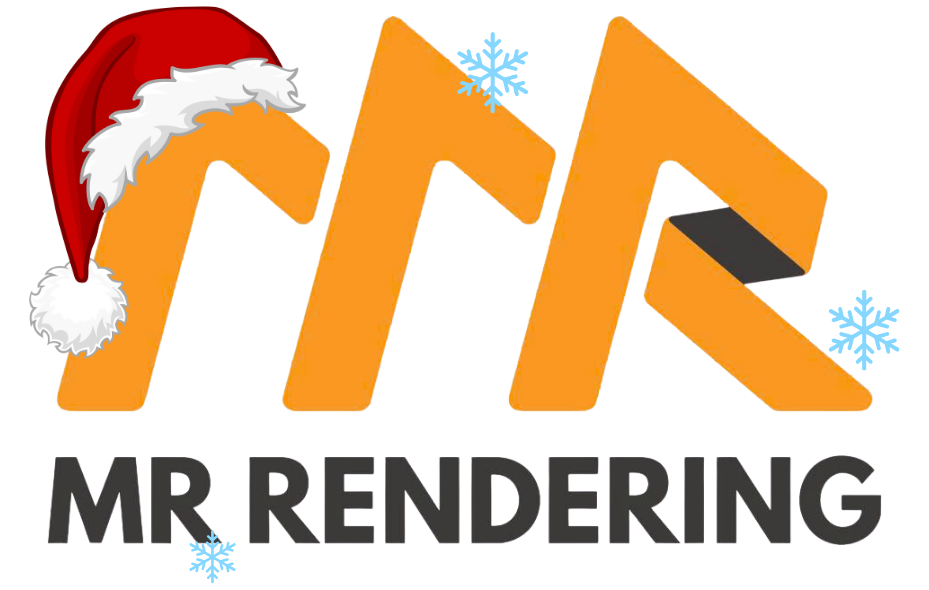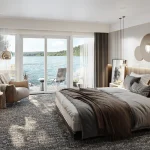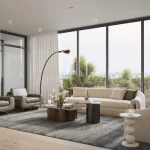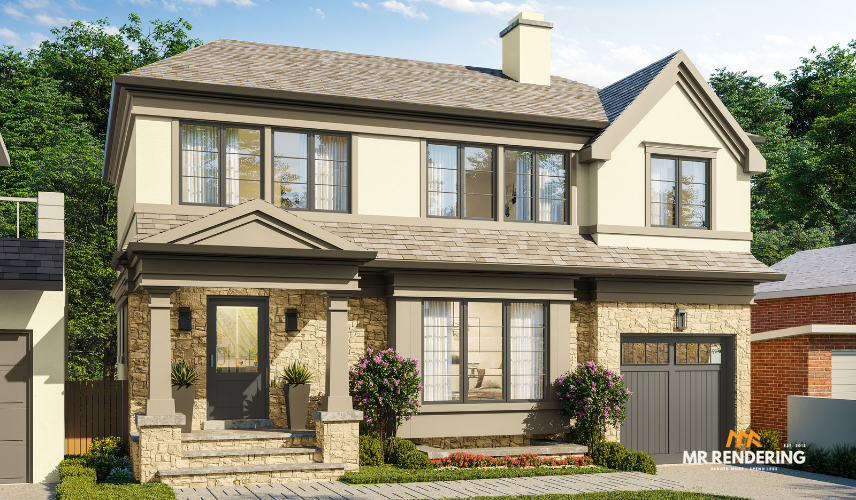
3D rendering New York professionals deliver is absolutely essential in a city defined by architectural ambition and the world’s most scrutinized real estate market. In this high-stakes environment where every new development competes intensely for attention, exceptional architectural visualization isn’t merely helpful—it’s a fundamental requirement. The unique demands for high-quality renders reflect New York’s sophisticated clientele, complex regulatory landscape, and market dynamics where presentation quality directly dictates project success and profitability. This intense landscape spans projects from luxury Manhattan towers to Brooklyn brownstones, demanding expertise that goes beyond technology to truly understand NYC’s unique architectural vocabulary and market expectations.
Why New York’s Rendering Market Is Uniquely Demanding
New York’s architectural context creates visualization challenges that rendering studios in other markets rarely encounter. The density and proximity of surrounding buildings mean that new developments exist in incredibly complex visual contexts—accurate photomontages and contextual renderings must account for dozens of neighboring structures, complicated sightlines, and the way new buildings affect views from multiple vantage points throughout the neighborhood.
Regulatory scrutiny in New York exceeds most other American cities. The Landmarks Preservation Commission reviews projects affecting historic districts with intense attention to how new construction relates to existing architectural character. The Department of City Planning requires detailed visual impact studies for projects affecting protected views and significant public spaces. These regulatory bodies demand visualization accuracy and sophistication that meets specific technical standards—rendering professionals serving the New York market must understand these requirements intimately.
The pace of New York’s development cycle compresses timelines dramatically. When a site becomes available or financing windows open, developers need renderings immediately—not in weeks but sometimes days. This urgency demands rendering studios with substantial capacity, proven workflows, and the technical infrastructure to deliver quality work rapidly without compromising standards.
Market sophistication among New York clients represents another distinguishing factor. Developers, architects, and brokers in New York have seen countless renderings throughout their careers—they immediately recognize quality differences and reject work that doesn’t meet their exacting standards. This educated clientele demands cutting-edge visualization technology, photorealistic quality, and creative excellence that stands out in a market saturated with architectural imagery.

Timeless Elegance: A Traditional Stone-Accented Home in New York
The Spectrum of 3D Rendering Services in New York
Residential development rendering dominates New York’s visualization market, reflecting the city’s luxury condo and rental apartment boom. These projects range from ground-up new construction to adaptive reuse of historic buildings, each requiring distinct visualization approaches. Luxury developments in neighborhoods like Tribeca, West Chelsea, or the Upper East Side demand renderings that communicate refined sophistication, emphasizing high-end finishes, generous proportions, and lifestyle amenities that justify premium pricing.
Commercial real estate rendering serves the office, retail, and hospitality sectors that drive New York’s economy. Office tower renderings emphasize street presence, lobby grandeur, and how buildings enhance the corporate identity of future tenants. Retail visualizations focus on storefront design, pedestrian flow, and how commercial spaces activate street life. Hospitality renderings for hotels and restaurants showcase atmosphere and experience, going beyond architectural form to communicate the venues’ character and appeal.
Mixed-use development visualization has become increasingly important as New York embraces projects that combine residential, commercial, retail, and community spaces. These complex programs require renderings that communicate how different functions coexist successfully, how street-level retail creates vibrant pedestrian environments, and how residential components provide sanctuary above the urban energy below.
Interior rendering complements exterior visualization, particularly for luxury residential projects where unit interiors drive purchasing decisions. High-end developers invest in renderings of multiple unit types, common amenity spaces like fitness centers and lounges, and even individual rooms showcasing different design schemes that help buyers envision personalization possibilities.
Specialized visualization services including virtual reality experiences, animated fly-throughs, and interactive 3D rendering New York models are gaining traction in New York’s competitive market. These advanced deliverables help projects stand out in crowded marketing landscapes, providing immersive experiences that static renderings cannot match. For ultra-luxury developments where units sell for tens of millions, these premium visualization investments represent tiny fractions of transaction values while potentially influencing purchase decisions dramatically.
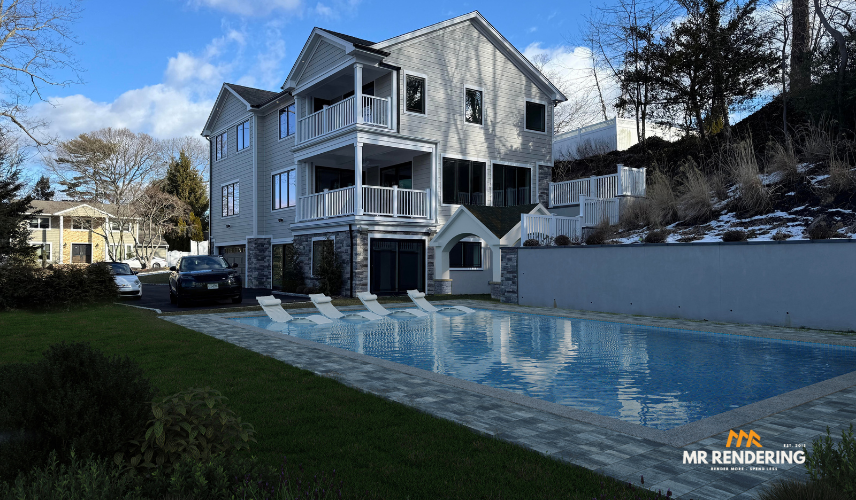
Modern Waterfront Living with Expansive Pool in New York
Finding Exceptional Rendering Studios in New York
New York City’s unparalleled concentration of architectural talent means clients have access to world-class rendering services right on their doorstep. However, quality and cost can vary significantly. Discerning the truly top-tier studios—whether local or global—involves evaluating several key characteristics.
A studio’s portfolio depth and diversity are primary indicators of versatility. The best firms showcase consistent excellence across a range of project types—residential, commercial, mixed-use—demonstrating their ability to adapt to the specific stylistic and technical demands of your project, regardless of its nature.
Local knowledge certainly offers advantages. Studios deeply familiar with New York’s unique architectural character often have an intuitive grasp of how a building should relate to its specific borough context, what design elements resonate locally, and how to capture the city’s distinctive light and atmosphere. However, skilled global studios can achieve similar authenticity through meticulous research, detailed client briefs, and a commitment to understanding the project’s specific environment.
Underlying all great visuals is robust technology infrastructure and software expertise. Leading studios continuously invest in the latest rendering engines (like V-Ray or Corona), advanced 3D modeling tools, and the powerful hardware needed for photorealistic quality and efficiency. Crucially, their teams often include specialists with architectural backgrounds, enabling smoother collaboration with design firms who speak the same professional language.
Beyond the visuals, communication responsiveness and professional project management heavily influence client satisfaction. Look for studios that provide clear project timelines, maintain proactive communication with regular progress updates, and offer a flexible process for handling the inevitable revisions that arise as designs evolve. This client-focused approach, whether from a local firm or a trusted offshore partner like MR Rendering, is highly valued by busy New York professionals.
Finally, turnaround time capabilities reflect a studio’s operational maturity and efficiency. In New York’s fast-moving market, opportunities arise quickly. Exceptional studios, including well-established offshore firms based in advantageous locations like Vietnam, maintain the capacity to handle urgent requests without compromising quality. They leverage streamlined workflows, efficient render farm infrastructure, and sometimes even time-zone differences to compress timelines when necessary, offering invaluable flexibility. Evaluating these factors helps firms find the right balance of quality, service, and value, whether sourcing locally or exploring global partnerships.
| Find out Top architectural 3D rendering studios in Vietnam now!
Understanding 3D Rendering New York Costs and Value
Pricing for 3D rendering services in New York reflects both the city’s higher operating costs and the sophisticated quality level the market demands. Exterior renderings for residential projects typically range from $800-2,500 per image depending on complexity factors: building size and architectural detail, surrounding context requirements, landscaping and environmental elements, lighting scenarios, and photomontage versus pure CGI approaches.
Commercial and mixed-use project renderings command higher prices reflecting increased complexity, often ranging $1,500-4,000+ per image for premium quality work. These projects frequently involve more intricate facades, complex street-level programming, and multiple stakeholder requirements that demand additional refinement and revision cycles.
Interior renderings typically cost $600-2,000 per image, with luxury residential interiors at the higher end reflecting the detailed furniture, fixtures, finishes, and styling that these visualizations require. Amenity space renderings for residential developments—fitness centers, lounges, rooftop terraces—fall into similar ranges depending on size and detail level.
Animated visualizations and fly-throughs represent substantial investments, typically starting around $5,000 for simple animations and ranging upward to $50,000+ for complex cinematic productions with multiple scenes, advanced camera work, and sophisticated post-production. These premium deliverables serve ultra-luxury projects where visualization budgets represent tiny fractions of overall marketing investments.
Value considerations extend beyond per-image costs. The best rendering investments accelerate sales timelines, enable pre-construction marketing that funds projects earlier, reduce expensive late-stage design changes, and enhance pricing power through superior presentation. New York developers consistently report that professional rendering investments return multiples through faster absorption, higher unit prices, and reduced carrying costs that compound throughout project timelines.
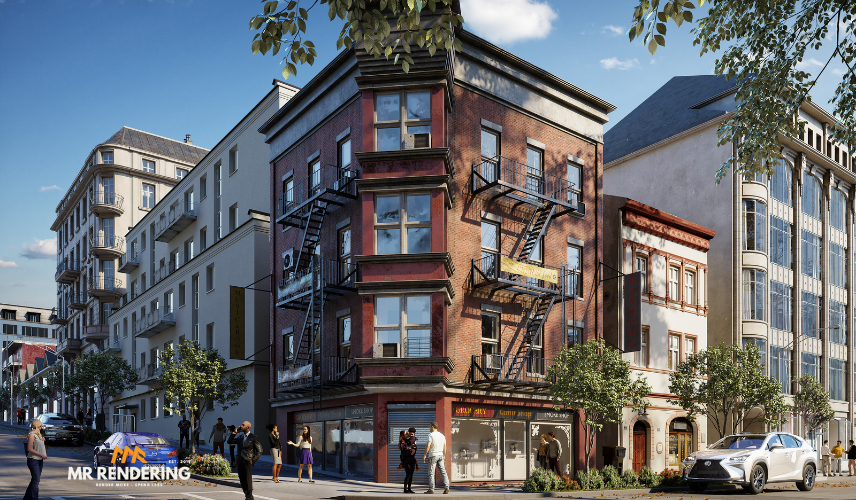
Classic Urban Corner: A Slice of New York Architecture | Explore more 3D Rendering United State projects
Maximizing Your Rendering Studio Partnership
Successful rendering collaborations begin with thorough project briefings that communicate vision clearly. Providing comprehensive documentation—architectural drawings, material specifications, reference images showing desired aesthetic direction—enables studios to minimize revision cycles and deliver results aligned with expectations from initial presentations.
Establishing realistic timelines protects both parties. Rush requests cost more and may compromise quality, while appropriately paced projects enable thoughtful refinement that elevates final results. Most exterior renderings require 1-2 weeks for initial delivery with additional time for revisions, while complex photomontages or animations demand longer timeframes.
Revision expectations should be clarified upfront. Most studios include 2-3 revision rounds in base pricing, with additional changes billed hourly or per revision cycle. Understanding what constitutes a revision versus a scope change prevents misunderstandings—adjusting camera angles or lighting scenarios typically represents scope changes rather than revisions to agreed concepts.
Final deliverable specifications ensure renderings serve all intended purposes. Discuss resolution requirements for various applications: web use requires lower resolutions while printed marketing materials demand high-resolution files. File format preferences, color profile specifications for print accuracy, and usage rights for derivative works should all be documented clearly.
The Future of Architectural Visualization in New York
New York’s rendering industry continues evolving rapidly as technology advances and client expectations rise. Real-time rendering engines borrowed from video game development enable interactive presentations where clients adjust lighting, materials, and viewpoints dynamically. This technology will increasingly become standard for luxury projects where customization and client engagement justify the additional investment.
Artificial intelligence is beginning to influence rendering workflows, with machine learning algorithms accelerating repetitive tasks like material application and lighting setup. However, the creative judgment and artistic sensibility that distinguish exceptional renderings from competent technical work remain firmly in human hands—AI augments rather than replaces skilled visualization professionals.
Virtual and augmented reality experiences are transitioning from novelty to practical tools for project marketing and design validation. Being able to walk through unbuilt spaces virtually or see proposed buildings overlaid on actual sites through phone cameras creates compelling experiences that resonate with tech-savvy buyers and sophisticated institutional clients alike.
For architects, developers, and real estate professionals operating in New York’s hyper-competitive market, partnering with exceptional rendering studios isn’t optional—it’s essential infrastructure for project success. The visualization quality you present directly influences how clients, investors, and buyers perceive your project’s quality and value. In a city where perception often becomes reality and presentation quality correlates directly with pricing power, investing in world-class 3D rendering services delivers returns that compound throughout project lifecycles and across project portfolios.

Content Writer, Copy Writer
As a passionate content writer, Hoang Phuong specializes in creating high-quality, compelling narratives around 3D rendering and architectural visualization. Leveraging deep industry knowledge, Phuong excels at delivering information that is not only clear and creative but also genuinely inspiring, fostering stronger connections with clients and fellow professionals alike.
